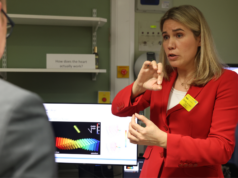
A group of engineers and physicians have created a wearable ultrasonic device that is able to provide continuous, real-time cardiac function assessment. As published in Nature, the portable device is said to use custom-built artificial intelligence (AI) technology to analyse the left ventricle from different angles during motion, automatically extracting data concerning ventricular volume and waveforms of key cardiac performance indices such as stroke volume, cardiac output and ejection fraction.
Aiming to make ultrasound more accessible to the population, Sheng Xu (University of California San Diego, San Diego, USA)—who is leading the project—and colleagues’ mobile echocardiogram (ECG) device looks to update the current examination process requiring “highly trained technicians and bulky devices. ”
The project builds on the team’s previous development of wearable imaging technologies, which were able to capture signals on the skin. “The increasing risk of heart diseases calls for more advanced and inclusive monitoring procedures,” said Xu. Xu has stated that the project hopes to identify cardiovascular disease early by recording “more thorough details” to spot issues with heart function when the body is in motion.
The device that measures 1.9cm (L) x 2.2cm (W) x 0.09cm (T)—which is estimated to be the size of a postage stamp—is built on styrene-ethylene/butylene-styrene (SEBS) and can be worn for up to 24 hours. Using an orthogonal configuration, the researchers posit their design eliminates the need for manual rotation to capture a comprehensive view of the heart.
Evaluating frame-by-frame quality of the generated cardiac images, the team designated five “crucial” metrics for anatomical imaging: spatial resolution (axial, lateral and elevational), signal-to-noise ratio, location accuracy, dynamic range and contrast-to-noise-ratio. When choosing the transmission configuration of the transducer array, they achieved superior results through wide-beam compounding transmission. They also selected from nine popular models for machine-learning-based image segmentation, landing on FCN-32, which achieved the highest possible accuracy for cardiac imaging.
Xu and colleagues contend that, compared to existing non-invasive methods, their wearable heart monitoring system will “enable anybody to use ultrasound imaging” and provide wide-ranging insights on “difficult to capture” pumping activity even when engaged in exercise. Additional applications of the device include minimised patient discomfort as well as diminished exposure to radiation, which is associated with computed tomography (CT) and positron emission tomography (PET) scan technology, the authors state.
Outlining next steps for the device, Xu and colleagues aim to do the following:
- Implement B-mode imaging, extending diagnostic capabilities to different organs
- Design a soft imager, allowing researchers to fabricate large transducer probes to cover multiple positions simultaneously
- Miniaturise the back-end system that powers the soft imager
- Work toward a general machine learning model that fits more subjects
Additionally, Xu plans to commercialise the technology through Softsonics, a branch of UC San Diego he co-founded with fellow engineer, Shu Xiang, and seeks to encourage others in the scientific community to continue research on this area.










